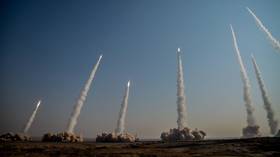Blood Moon rising: Longest lunar eclipse of the century burns dark red (PHOTO, VIDEO)

Avid astronomers and amateur stargazers the world over were treated to an incredible lunar light show when the moon transformed from its usual bright color to an orb of burned orange and red for nearly two hours.
The quirky color change was part of the longest lunar eclipse of the century, with people from as far away as Germany, Greece and Turkey to South Africa and Australia capturing images of how the moon appeared to dim as it became aligned with the Earth and Sun.
Friday’s incredible eclipse lasted 1 hour and 43 minutes, with many people, including European Space Agency astronaut Alexander Gerst, taking to social media to marvel at the fleeting reddishness of the moon.
Lunar eclipse photo update from Abu Dhabi. Spectacular! Photo credit belongs to Souhayl Ben Khaled, UAE Astronomy group. We'd love to see the view from where you are! pic.twitter.com/WVkHmgdNSZ
— NASA Moon (@NASAMoon) July 27, 2018
Istanbul Turkey pic.twitter.com/uIZOwNzsW5
— sigarayıbırak 💛❤ (@kacakcayhostur) July 27, 2018
blood moon over munich suburbia#BloodMoon#Munich#suburbiapic.twitter.com/0JNiFgP5B7
— liz silver (@astronette1) July 27, 2018
Gerst, who recently took part in a Kraftwerk concert from his position on the International Space Station, managed to take a photograph of the eclipse in full sway from the manmade satellite 408 kilometers above earth.
Just took a photo of the #LunarEclipse from the @Space_Station. Tricky to capture. The slight hue of blue is actually the Earth's atmosphere, just before the Moon is "diving into it". #Horizonspic.twitter.com/X8r7puloQl
— Alexander Gerst (@Astro_Alex) July 27, 2018
The phenomenon occurs when the moon and the sun are at opposite sides of the Earth. The only sunlight hitting the moon comes from the surrounding edges of our planet giving the lunar landscape a reddish hue or burnt red color.
NASA said the reason the eclipse lasted more than one hour and 40 minutes was because the moon went “directly through the center of the Earth’s shadow.”
“It has more shadow time. It is also moving slower than average because it is at its farthest point from the Earth in its elliptical orbit,” NASA added in a statement online.
Blood moon in Copenhagen.Photo by me pic.twitter.com/uHKtQwjF9A
— ʾUstādh ʾAbū Hipster (@erimcicekk) July 27, 2018
Like this story? Share it with a friend!














